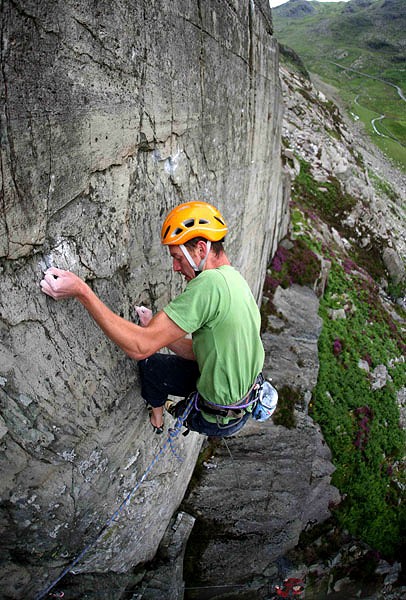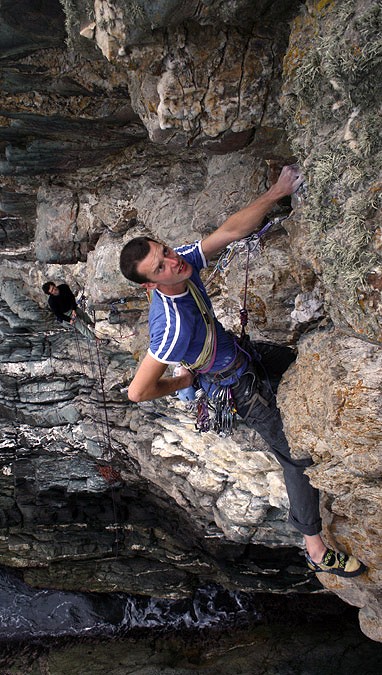The E Grade. Is it broken? Can it be fixed?
Read E is for mEdia, to find out if the climbing media really controls top end grading.
I am assuming that all those reading this article are familiar with the British grading system to a certain degree. If not it is explained quite fully HERE (Rockfax Website). There is a comprehensive look in to the history of the British grading system HERE (Bob Wightman's Site).

How the British Grading system differs from others:
The British E grade encompasses not only the physical difficulty of the route, but the seriousness of the route as well. This gives us the unique position of being able to have three routes of the same grade being completely different in terms of physical difficulty:
Route |
Grade |
Level of Protection |
Physical Difficulty |
London Wall |
E5 6a |
Well Protected |
High |
Right Wall |
E5 6a |
Semi-Protected |
Medium |
The Long Run |
E5 6a |
Badly Protected |
Low |
Why do they all get the same grade?
The beauty of the E grade system is that it encompasses how difficult a route will 'feel' overall, both physically and mentally. Making moves above poor protection will feel harder than the same moves above good protection. Equally making lots of 6a moves in a row will feel harder than making one 6a move. These factors are taken in to account in the E system, hence why The Long Run is graded E5 even though the climbing is much easier than on London Wall.
E grades are for the On Sight?
E grades are supposed to represent how difficult a route feels to climb on sight. This means with no prior knowledge of where to go, or what gear to use. A climber will need a lot of physical and mental strength in reserve to hang around and work out sequences, place gear, reverse from dead ends, wiggle in more gear and eventually climb to the top. This is a very different experience from climbing a route after practice, and this is at the heart of the E grade - encompassing both the physical and mental aspects of the route. The mental challenge is much higher when climbing on-sight.
As mentioned in my editorial, E is for mEdia, there are some top climbers who don't feel that E grades are correctly used after headpointed ascents. Here is an example that shows how these 'second guess' high E grades are hard to get right:
Big John climbs a new route after extensive top-rope inspection. He places lots of gear that his many days on a top rope have allowed him to find. He uses hidden holds and sneaky rests. He has tested the gear by dropping a rucksack on to it, so he knows which pieces are good and which are not. He reduces the level of fear he will experience because he knows what gear to expect and where the bold sections of the climb are.
Big John then proposes (guesses) a grade to represent how hard the route will feel to a climber that has never top-roped the climb, has not tested the gear and has no knowledge of any of the moves, rests or gear placements. Obviously that is difficult to do.
Conversely, the French system gives an indication of the physical difficulty of the route, assuming that the climber uses the easiest possible sequence. This is much more black and white and easier to propose.
Climbers in the past have broken free from this 'second guessing' E grade system; In 2001 John Arran graded Doctor Dolittle, his new route at Curbar Edge in the Peak District, H9 (H standing for Headpoint). “I was unwilling to guess an onsight grade, I proposed H9”.
Steve McClure graded his new route The Elder Statesman, also in the Peak District, HXS 7a, because he was unsure how hard it would be to climb on-sight.
In a recent UKC Article, top UK trad climber Pete Robins said “It would be much better if E-numbers didn't exist for head-points and they were just given a sport grade until they were on-sighted.”

Does it really matter if some top E grades are a bit out?
The H system hasn't caught on, perhaps because a two tier system that changes with the style of ascent (H9 becomes E9 after an on-sight ascent) is complex, and also perhaps because top climbers arguing over E9 or E10 are few in number (but high in passion). So we are still in a situation where grading a route with a 'second guess' E grade isn't a perfect system either. That's because there is no perfect system, as any grading system is open to abuse or disagreement.
What is worth remembering is that proposing grades at this level is not an exact science, whether the route has been top-roped or not.
Climbers attempting hard and bold routes on-sight are usually extremely experienced and know that the grades at this level are only a rough guide.
Dave Macleod's Thoughts:
| Dave is headpointing so far above current on-sight standards, that I had to find out his thoughts about current top end grading. Here is part of our conversation: |
| Dave: "I think you should take account that not everyone is using this system of 'grading for the theoretical onsight', but rather comparing directly to the overall difficulty of other headpointed routes. I stuck my neck out and gave Rhapsody E11 because it was miles harder than any of the E10s I'd been on or done. As for Echo Wall I don't feel like I can grade it because there's nothing else like it. I know it's harder than anything I've tried, but I don't have enough references to settle with and confidence at all on a grade guess." |
| Dave was happy for me to quote this from his blog: |
| "Grades are generally given for an onsight ascent. However, the many new routes above E7/8 have all been opened after abseil cleaning/inspection and/or top rope practice. Therefore, predicting what it would be like to onsight E10 is impossible. Who knows what that will be like? No-one at the moment anyway. We can only give grades based on a subjective feeling of increments of overall difficulty we experience. Grading can work perfectly well that way, although it is subject to the same complications it always had (hyping, sandbagging, new sequences etc.) People assume that grading systems are a mess just because they either don't understand how they work or do not take into account the subjectivity of grading." |
Also worth noting is that guidebooks generally have quite a full description for hard and bold routes, and this can add a lot of information that a grade cannot encompass. (Two and a half pages of text for The Indian Face was perhaps a little too much!). So we can conclude that the more information available on these routes, the better informed potential on-sight climbers will be, and that includes the valuable 'second guess' E grade.
The FRCC made an extremely useful and positive step forward in their 1999 Lake District Langdale guide. In the graded list they state:
It is considered by some climbing at the highest standards that French grades provide information not currently available from the normal British grade. Therefore as an experiment, traditional routes of E6 and above have also been given a French grade in the Graded List, in addition to their British E grade... ...This step represents perhaps the beginning of an overhaul of the grading system at this level, based on the emerging thoughts of some of those most qualified to comment. It will be interesting to see how the debate develops.
This adds another piece of information to help a would be on-sight climber asses the difficulties they are likely to face and it has proved popular and useful. These days most hard new routes are quantified with a French grade when they are reported in the press (and crux moves are often described with bouldering grades). The inclusion of these 'extra' grades in to our guidebooks would be a worthwhile and helpful exercise.
The Real Issue?
If however the real issue is not with providing climbers with accurate information, but with on-sight climbers not receiving the media recognition for their achievements that they deserve, and feeling over-shadowed in the press by the big number head-points, then the problem lies not with the grading system itself but with the climbing media. |
-
See E is for mEdia for my thoughts on that.



Comments